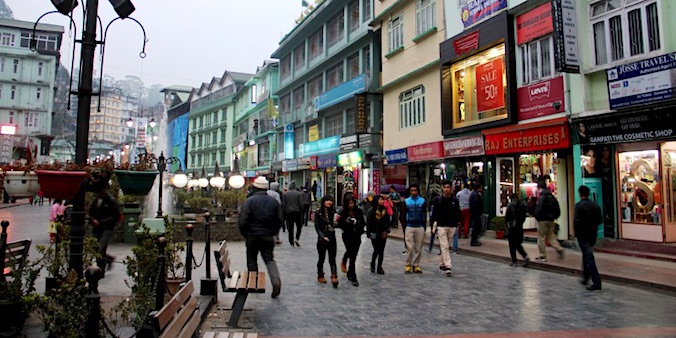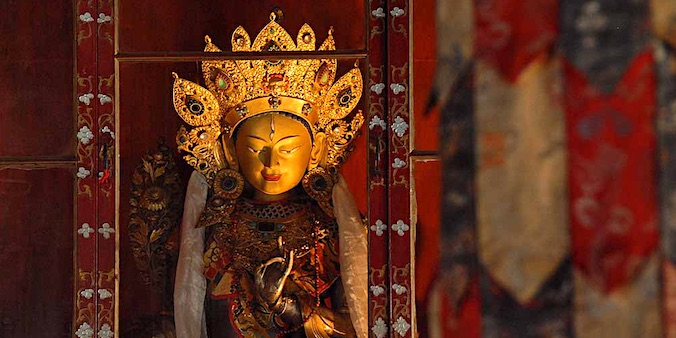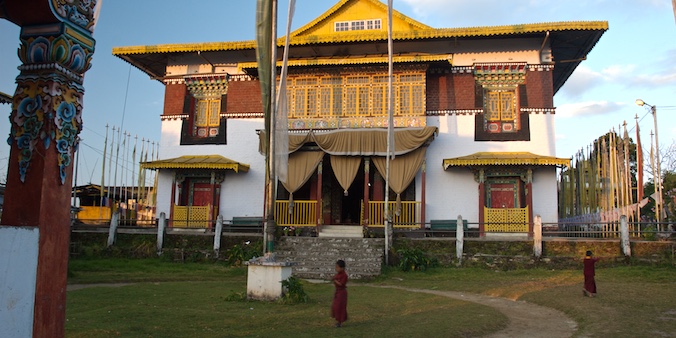Tour - 16 days/ 12 days trekking
About Darjeeling & SIKKIM
Sikkim and neighboring Darjeeling have a lot to offer to mountain lovers, aficionados of Buddhist culture and trekkers. Wedged in between Nepal, Bhutan and Tibet but part of India – this region shares a lot with these areas.
Sikkim is a gem of cultural and natural diversity. Until 1974 it was an independent kingdom, now it is part of India. It is home to different Himalayan peoples, most from Nepali descent or originating from Tibetan and Bhutan, such as the Bhutias who brought Buddhism to the area four centuries ago. Thanks to them Sikkim boasts of colorful Buddhist monasteries and Buddhist festivals. The Lepcha’s, until a few decennia ago forest-dwelling animists, hold a unique culture that the Sikkimese government is trying to preserve.
Sikkim’s mountains range from 200 m to 8586 m and walkers and trekkers can choose from jungle treks or low altitude village treks, staying at home-stays, to high altitude treks that bring one up-close with some of the Himalayas’ highest peaks, like on this tour. Trekking, and other forms of eco-friendly tourism are strongly supported by the Sikkimese government, which has a track-record of measures and policies aimed at sustainable development
Region
Sikkim
(India)
Best Time
April-mid June &
Oct-Nov
No. Of Days
16 days, 12 days trek
Trip Character
Trekking tour
Sleeping Altitude
1650 - 4100 m
Trek Character
Camping trek
Level: 3
Price
INR XXX/ $ XXX
ABOUT THIS TOUR
On this tour, you’ll be trekking along the border between Sikkim (India) and Nepal. The border follows a north-south running mountain ridge here, known as the Shingalila Ridge. The well-known Shingalila Ridge Trek runs along and over the southern portion of this ridge in West-Bengal till the border between West-Bengal and Sikkim.
This trek is different. It basically starts where the well-known Shingalila Ridge trek ends: on the Sikkimese side of the Shingalila Ridge. It takes you higher and much closer to the highest peaks of the world, affording you even more grandiose views of these natural skyscrapers. Then it crosses over to yet another trek that takes you even higher: the Goecha La (or Kangchenjunga) Trek, leading up to the 4940m high Goecha La pass. Here, you will get breathtaking views of Mt. Kangchenjunga, the world’s third tallest peak (8586 m).
This trek starts at only 1600m amidst lush green subtropical forests and villages surrounded by terraced fields of rice, wheat, maize, millet, and cardamom, and then traverses several altitudinal stages, including dense Rhododendron forests hat blossom profusely in spring, before ending at high-alpine yak meadows. Not only does it offer unparalleled views of the Himalayas’ giants, it also presents an overview of all the altitudinal stages that lie below this world of rocks and ice, and this in an area that is particularly well preserved.
YOUR custom-made TRIP
The tour described here, as well as the other ones on our website, are mainly meant as suggestions. We would be happy to offer you a travel proposal that fully meets your personal demands and expectations. That means that you choose where you want to go, what level of accommodation and type of transport you want and what activities you prefer.
Please let yourself be inspired by this and other trips on our website and then drop us a line (or call us) to explain your travel wishes. We will be happy to help you put together the perfect trip. You can reach us over e-mail, Messenger, Whatsapp or mobile phone.
EXTENSIONS & VARIATIONS
Apart from the tour as described here, you could consider the following add-ons and changes:
- Visit Darjeeling before the trek. Darjeeling was the former summer capital of British India and it has preserved much of the old-world charm, besides being world-famous for its tea and tea estates. Staying here a few days, at 2040m, will also add to your altitude acclimatisation.
- Travel further north – by car – into the Sikkimese Himalayas and explore the isolated ‘Tibetan’ hamlets of Lachung and Lachen. See here.
ITINERARY
-
Day 1: Delhi ✈︎ Bagdogra - Gangtok (2 h flight, 4 -5 h drive)
The flight to Bagdogra takes less than 2 h and, in clear weather, offers wonderful views of the Himalayas, including Mt. Everest (8848m) and Kangchenjunga (8568m). At the airport our guide and driver await you, and take you to Gangtok, Sikkim’s quaint, but relatively hip capital. Altitude 135 → 1650m → 2350m. -
Day 2: In Gangtok
Early morning, we can witness a spectacular sunrise over the Kanchenjunga massif from Tashi view point. Later on, we visit the famous Rumtek Monastery, not far from Gangtok. In the evening, we take a stroll on Mahatma Gandhi Marg, the heart of Gangtok city. Altitude 1650m -
Day 3: Gangtok - Pelling (4 h)
The small town of Pelling – to the west - is best known for Pemayangtse Gompa, one of the most famous Buddhist monasteries of West Sikkim. Next we walk to Sanga Choling monastery by climbing the steep forest track of 4 km to the ridge top. Altitude 1650m → 1930m. -
Day 4: Pelling - Darap & trekking to Rimbi (3 h walking )
First we visit the interesting Rabdantse Palace ruins, part of a former Sikkimese capital. In the afternoon we start the 12-day trek in Darap by walking leisurely along a rough road to our camp in Rimbi. Altitude 1930 → 1550m → 1600m. -
Day 5: Trekking Rimbi - Chongri (5 h walking)
The mostly tree-shaded trail is teeming with birds and butterflies. It follows the Rimbi river till Sanghkhola, where you can take a dip in the stream. Then follows a steady climb to Chongri with beautiful mountain views along the way. Altitude 1600 → 2175m. -
Day 6: Trekking Chongri - Nayapatal (5 h walking)
The uphill trail soon leads through a valley, then goes through a dense forest alive with singing birds and buzzing insects, and is frequented by deer and black bears. Altitude 2175 → 2500m. -
Day 7: Trekking Nayapatal - Upper Yambong (7 h walking)
Today’s walk is quite demanding. The trail first winds its way up through forest of pines, hemlock and silver firs, then crosses a marshy area, and climbs again until we reach the tree line, where the vegetation changes into shrubs, wild flowers and colourful mosses. Altitude 2500 → 3735m. -
Day 8: Trekking Upper Yambong – Daphe Bhir (7 h walking)
On our way to the Daphe Bhir pass we skirt two lakes located against a backdrop of spectacular mountains like Kangchenjunga (8585m), Kabru (7317m) and Pandim (6691m). While zigzagging to the first pass you may be captivated by the sound of jingling yak bells and whistles from the yak men. The main pass at 4500m is marked by hundreds of prayer flags and again offers magnificent scenery. Our camp is just a bit further down. Altitude 3735 → 4500 → 4420m. -
Day 9 Trekking Daphe Bhir - Yanseb (7 h walking)
First we descend almost 700m to the Gomathang valley, then cross a few small rivers, and gradually climb to the beautiful camp at Yanseb. Altitude 4420 → 3750 → 4100m. -
Day 10: Trekking Yanseb – Pangding (6–7 h walking)
We continue contouring until we reach a small pass (4310m), adorned by prayer flags and with wonderful views. After a short descent the trail climbs steeply, then turns a corner to reveal a spectacular view across a wide ridge, to Mt. Kabru and Pandim. Altitude 4100 → 4310 → 4275m. -
Day 11: Trekking Pangding – Dzongri (5 h walking)
Just as the sunset was stunningly impressive the night before, so is the sunrise. Today’s walk first goes downhill to the Bikbari valley floor, from where we start the climb to Dzongri. Near the camp is a superb viewpoint for sunset and sunrise on Kangchenjunga and nearby giants. Altitude 4275 → 4050m. -
Day 12: Trekking Dzongri – Lamune (6–7 h walking)
From Dzongri, we follow the original Kangchenjunga trek to the Goecha La, where we probably meet more hikers. First we follow a scenic ridge for about 5 km, then descend a steep spur and climb to grassy Thangshing. Eventually we reach lovely and sacred Samity Lake and walk down to Lamune. Altitude 4050 → 4100m. -
Day 13: Trekking Lamune – Goecha La View Point – Thangsing (6-7 h walking)
Starting at pre-dawn we make the 2h climb to the 4940m high Goecha La viewpoint and are surrounded by magnificent peaks like Mt. Pandim, Kanchanjunga, Kabru, Talung and Guicha. The area beyond this view point is now a Conservation Zone for Snow Leopards and Blue Sheep and off-limits. We return to Lamune and descend to Thangsing. Altitude 4100 → 4600 → 3800m. -
Day 14: Trekking Thangsing – Bakhim (6–7 h walking)
The long descent initially leads through dense rhododendron forests and ends at the relatively ‘warm’ hamlet of Bakhim. From the camp, we look out on ridge after ridge of temperate forests and to the river far below. Nearby you can try the local millet ‘beer’. Altitude 3800 → 2750 m. -
Day 15: Trekking Bakhim – Yuksom (5 h walking)
We descend all the way to the river, then enter a narrow valley through thick, semi-tropical forest, and follow the river. This involves several ascents and descents and crossings of tributaries. Wayside waterfalls provide plenty of opportunity for bathing! In Yuksom, we check in at a hotel. Altitude 2750 → 1750m. -
Day 16: Yuksum - Bagdogra ✈︎ Delhi (4 h drive, 2 h flight)
After breakfast you descend to Bagdogra where you check in for the flight to Delhi. It depends on the timing of your international flight whether you will need an overnight stay in Delhi. In the latter case we can arrange this for you.
HIGHLIGHTS OF THIS TOUR

Gangtok
In Sikkim’s capital Gangtok, the rear neighbours almost always live on another street and hardly anyone has a garden, because the slopes are too steep for that. This also means that the roads are nowhere wide and often clogged. But fortunately most locations in the city can be reached on foot. Pedestrians can use a whole series of footbridges to cross busy roads. Gangtok was also the first city in India to declare its centre a pedestrian area. Here it is pleasant to stroll and shop and there are numerous ‘hip’ restaurants and cafes. Thanks to the government’s serious approach to environmental problems – a rarity in India – this is also one of India’s cleanest city centres. Interesting places to visit include the flower exhibition – with many varieties of orchids, – the Institute of Tibetology, Enchey Gompa and Tashi Viewpoint.
Rumtek Monastery


Pemayangtse Monastery
Pemayangtse Gompa was built by Lama Lhatsun Chempo in 1705, and it is one of the oldest monasteries in Sikkim. It was expanded by the third Chogyal (king) of Sikkim Chakdor Namgyal, who was considered the third incarnation of Lhatsun Chenpo. The monastery follows the Nyingma order (‘Old sect’) and is the main monastery of this order in Sikkim. The monks of the monastery are normally chosen from the Bhutias (ethnic Tibetans living in Sikkim since the seventeenth century). The top floor of the monastery houses a rare work of art made of wood, a seven-storey representation of Guru Rinpoche’s Celestial Palace (known as ‘Sanghthokpalri’ or ‘Zandog-palri’). Guru Rimpoche, also known as Padmasambhava, was one of the most important spreaders of Buddhism in the eighth century.



